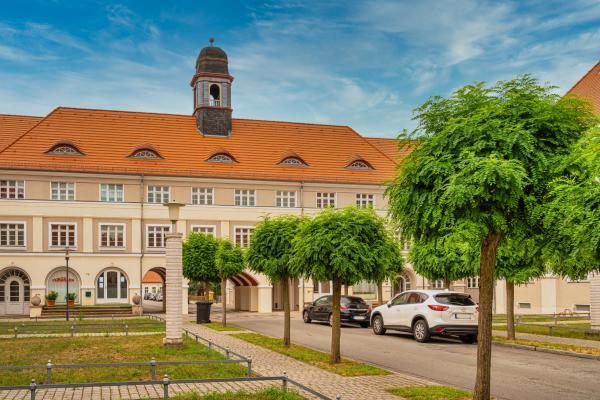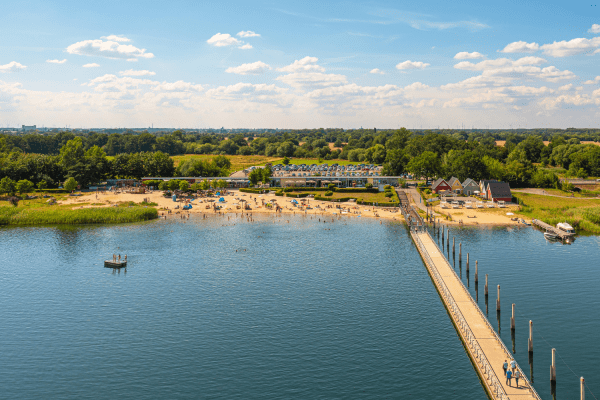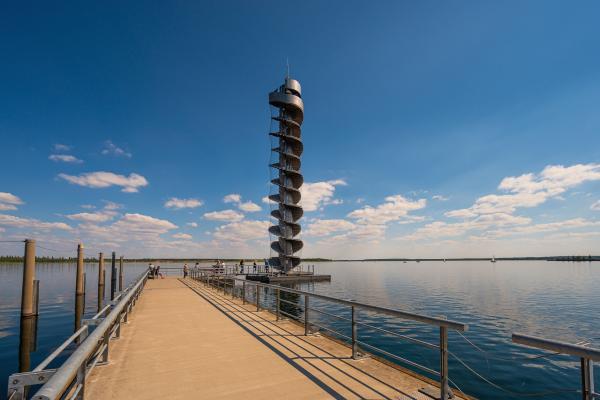Go on an exciting journey of discovery in a region that was an ecological emergency area due to lignite mining and chemical industry until the end of the GDR. Since the political turnaround in 1989, these ecological hotspots have been extensively redeveloped and converted into highly interesting tourist recreational landscapes with unique evidence of industrial history.
The stations on the route, some of which are located directly on the bike path, some of which can be reached via a detour, provide interesting insights into the history and present of this versatile region. All stations are also easily accessible by car.
The mining lakes that have been created have become particularly attractive for bathers, water sports enthusiasts and nature lovers. With excellent water quality, they provide an ideal habitat for numerous animal and plant species.
Visit also factory settlements at former lignite-fired power plants and be amazed at the sight of former large-scale open-cast mining equipment. Visit original sites where groundbreaking inventions and developments took place in the 20th century. Let your eyes wander over an active open pit mine and visit one of the most modern coal-fired power plants in Europe.
While the route is also interesting for children. Children's playgrounds, educational facilities - some with multimedia exhibitions-, nature trails, excursions and water sports on the lakes offer all kinds of variety.
Whether by bike or car - experience the change of the once powerful Central German industrial area to a cultural and recreational landscape!
Piesteritz factory housing estate
From 1916 to 1919, the New Building movement at the beginning of the 20th century left impressive stone traces in Piesteritz, which has been part of Wittenberg since 1951.
Futurea Science Center
What do hunger in the Third World, the environmental compatibility of diesel vehicles, daily dental care or the artificial production of natural substances have to do with Wittenberg's historic marketplace?
Lake Bergwitz
As early as the 1960s, an idyllic mining lake was created from the former open pit mine "Robert's Hope".
Forest house at the Bergwitzsee
A heath magnet for all friends of nature with an interactive exhibition and a movement and education area for young and old.
Gremmin lake
The flooding of the Golpa-Nord open-cast lignite mine near Gräfenhainichen created a local recreation area in 2000.
Ferropolis
FERROPOLIS - the city of iron - is an industrial museum on a peninsula in Lake Gremmin near Gräfenhainichen.
Factory housing estate Zschornewitz
In the immediate vicinity of the site of what was once the world's largest and most modern lignite-fired power plant.
Muldestausee
On the edge of the Dübener Heide Nature Park, an exciting and valuable biotope has been created at Muldestausee, providing a habitat for rare and endangered species.
HAUS AM SEE Schlaitz
The Information Center for Environment and Nature Conservation at the Mulde Reservoir tells the story of the transformation from a dredging empire to a natural idyll.
Book village Mühlbeck-Friedersdorf
In the book village of Mühlbeck-Friedersdorf you will find antiquarian bookstores offering more than a quarter of a million books to the visitor, reader or collector.
Great Goitzsche Lake
The Goitzschesee is an open pit lake and a scenic gem with a wide range of offers for water sports enthusiasts, recreationists and nature lovers.
Water level tower at the Goitzsche
The landmark of the Goitzsche lake region floats on the Goitzsche lake and offers a perfect all-round view.
Bitterfeld Water Center
The disused former Bitterfeld waterworks directly on the B 100 opposite the Goitzsche is now an information and education center on the subject of water.
District Museum Bitterfeld
Visit the Bitterfeld District Museum and take a look at the almost 800-year history of the town of Bitterfeld and its immediate surroundings.
Wolfen Industrial and Film Museum
The museum commemorates what was once the second largest film factory in the world, where AGFA or ORWO films were produced.
Palace of Culture Bitterfeld
The imposing neoclassical building is an architectural landmark and also has supraregional significance in its history.
Bitterfeld arch
The symbol for the change of the region allows a unique panoramic view of the Goitzsche lake region.
Lake Grabschütz
A lake reserved for nature conservation with a nature trail about 7 kilometers long.
Lake Werbelin
Lake Werbelin is a nature reserve and bird sanctuary with diverse landscape structures.
Bucket wheel excavator SRs6300
The 17-meter-high, 180-ton bucket wheel of what was once the largest excavator of its type is a contemporary witness from the Breitenfeld open pit mine.
Schladitz lake
Lake Schladitz surprises its visitors with numerous offers in, on and around the water.
Leipzig Schleußig and Plagwitz
According to the UNESCO list, Schleußig and Plagwitz are among the largest industrial area monuments in European cities.
Lake Cospuden
The development of Lake Cospuden from an open-cast lignite mine to a lively leisure oasis is exemplary for the region.
New Harth
Post-mining forest and lake landscape in the Leipzig Neuseenland.
Markkleeberg Lake
With crystal clear water, Lake Markkleeberg invites you to relax and swim.
Mining Technology Park Großpösna
The Mining Technology Park presents the complete production cycle of an opencast lignite mine in an exciting arc.
Lake Störmthal
To the south of the Markkleeberger See is its big brother, the Störmthaler See.
Lippendorf power plant
In the information center of the modern coal-fired power plant, interested guests can learn more about power generation.
United Schleenhain open pit mine
A lookout point offers visitors a view over the vast open pit area of the active Schleenhain open pit mine.
Lake Großstolpen
The relatively small lake is a very good example of the coexistence of local recreation and nature conservation.






























